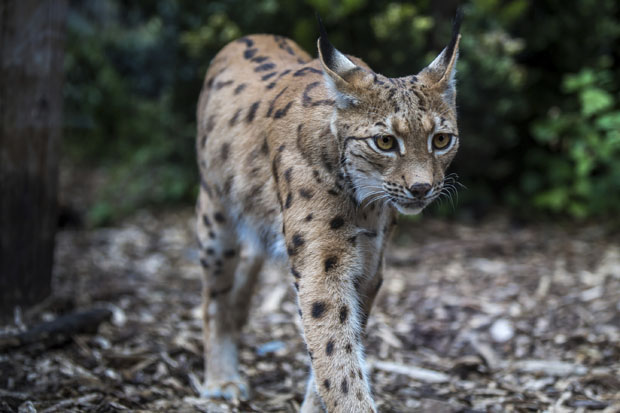Sometimes an idea is so barmy that worrying about it ever becoming reality seems pointless. So when the Labour MP Andy Slaughter asked the Environment Secretary a few weeks ago about re-introducing lynx to the English countryside, the instinctive reaction of all those listening must have been, ‘Yeah, right! Good one!’
In fact, the basis of Mr Slaughter’s inquiry was a concept known as ‘rewilding’, which is fast becoming the new obsession of the left and the avowed intent of the more fundamentalist members of the naturalist lobby. Not content with banning hunting and allowing foxes to wreak havoc, these radicals now want to replace traditional land management by farmers and gamekeepers with a form of natural anarchy in which every kind of beast roams our green and pleasant land, ripping other animals, and possibly humans, to shreds. And in the latest attempt to get this preposterous conceit off the drawing board and into government policy, its devotees have begun pushing for the return of lynxes and wolves.
Lynxes were wiped out in Britain in the seventh century, and if you are halfway sane you might be glad. It’s not as if they have nowhere to go. They are the third largest predator in Europe and classified as animals of ‘least concern’ conservation-wise. They wander the forests of Russia and in Finland their population is larger than ever. They need help to survive just as the Kray twins needed help to survive. They stalk their prey and then pounce, eating two kilograms of flesh a day. When a lynx escaped from Dartmoor Zoo in July — by chewing through the wire — it killed four lambs.
One would have thought that even a townie Labour MP could work out that this is not the sort of animal a family of four from Thornton Heath, or indeed Mr Slaughter’s own Hammersmith constituency, might like to meet on a nice Sunday walk in the country.
Similarly, the last wolf in the UK was shot in the 17th century, and those with good mental health might say, ‘Thank God for that.’ But no, let’s reintroduce them to the Scottish Highlands: ‘Wolves, lynx and other magnificent species would revitalise our living systems and enrich our lives,’ gushes Chris Packham, of BBC2’s Springwatch, on the Rewilding Britain website. (The BBC absolutely loves rewilding, of course, and sends a camera crew to interview whichever loon is standing on a moor advocating the introduction of ravening beasts.)
The campaigners are everywhere. The Wolves and Humans Foundation is pushing for, oh dear, it’s impossible to say. Reading their website, it looks as if they’re trying to find a way for wolves to eat humans without upsetting them too much — but it’s hard to tell. Lynx UK Trust has proposed a number of sites for the release of ten Eurasian lynx, including Northumberland, the Lake District and Thetford Forest in Norfolk.
Rewilding Britain’s euphemisms, meanwhile, are epic: ‘Wolves can turn grassland into forest and create habitats that hundreds of species can use, by keeping deer on the move…’ (Yes, by chasing and eating them.) ‘Wolves live in a huge range of habitats and human population densities. They present a very low risk to people… They are a tourist draw despite being shy creatures that avoid people where possible…We would have to manage livestock differently if wolves were present. There would need to be compensation schemes for the small number of livestock losses that would result.’ Are they having a laugh? Have they dropped acid while watching Dances With Wolves?
These people bang on about how re-introducing wolves transformed eco-systems in Yellowstone National Park, but Yellowstone is a 3,500 square mile wilderness. You can tinker with ecosystems by setting loose predators in that kind of space without them eating too many schoolchildren.
Clearly, the only coherent argument for re-introducing big cats and wolves to Britain might be to wipe out large numbers of deer in areas where deer are out of control. But why do the left suddenly want to have wild dogs tear Bambi limb from limb? Perhaps, they feel it is a more natural way to die than from a gun. But this is bizarre, given they don’t like hounds ripping foxes to pieces. As I say, there is no logic.
Unless you consider that rewilding is yet another outbreak of class warfare. Rewilding is in direct opposition to land management. And who manages land? The toffs. If you set enough big cats and wolves free to eat deer, pheasant, hare and salmon, you make the countryside a no-go area for hunting, shooting, fishing, riding — anything posh people do for fun. By releasing as many vicious carnivores as possible, you make it a pretty inconvenient place for the rural community, and, more importantly, for the landed gentry.
But there is a snag. You make life awful for the animals, too. Attempts at rewilding, primarily in Holland, have resulted in the most horrendous cruelty. And this is what the rewilders don’t want you to know. They don’t want you to see a YouTube video showing the wretched deer and horses in the 15,000 acre Oostvaardersplassen nature reserve, 25 miles east of Amsterdam, pressed up against the perimeter fences desperate for food, surrounded by the corpses of dead herd members being picked over by foxes and corvids.
In this rewilding experiment, the area saw no wildlife management. All animals were simply left to a ‘natural’ existence, with the result that many deer, cattle and horses starved, drowned in lakes or collapsed from exhaustion. Suddenly, an amusing idea isn’t all that funny. Rewilding is deadly serious for the poor creatures who have to suffer it.
Possibly, the rewilders want to return us to the primordial soup. If George Monbiot, author of Feral,the rewilding bible, could get hold of dinosaur DNA, presumably he would reintroduce megalosauruses to Oxfordshire because they were there first.
But it would be a mistake to think that rewilding is a wild idea going nowhere. It is already being subtly established in principle in the way some trusts manage public land. Where I ride, Surrey Wildlife closes off a large section of the main bridleway on Ockham Common every summer to help adders and other reptiles to breed. A few years ago, the trust also chopped down hundreds of pine trees to ‘return’ the common to heathland. The place looked like Armageddon, a burnt, smoking wasteland. And the adjoining M25, never all that audible, was now a deafening roar because of the lack of sound barrier once provided by the forested areas.
With no trees and lots of poisonous snakes, the common is now ‘as nature intended’. It’s just not as nice.
The post The missing lynx? appeared first on The Spectator.
Got something to add? Join the discussion and comment below.
Get 10 issues for just $10
Subscribe to The Spectator Australia today for the next 10 magazine issues, plus full online access, for just $10.
You might disagree with half of it, but you’ll enjoy reading all of it. Try your first month for free, then just $2 a week for the remainder of your first year.















Comments
Don't miss out
Join the conversation with other Spectator Australia readers. Subscribe to leave a comment.
SUBSCRIBEAlready a subscriber? Log in